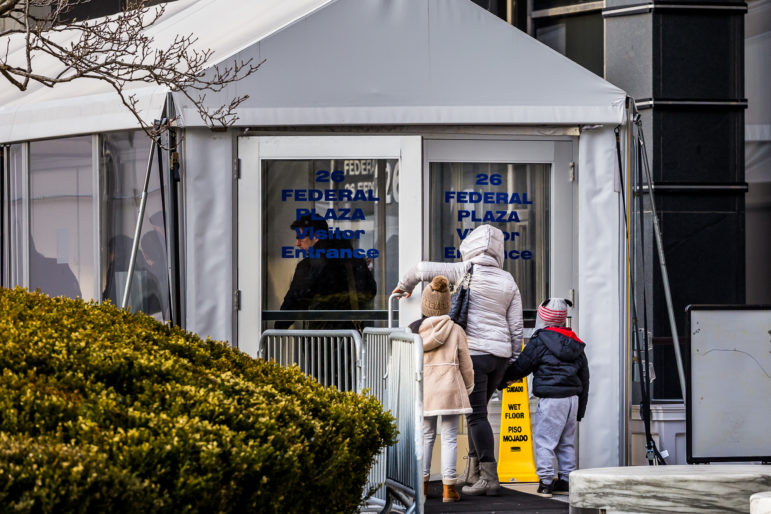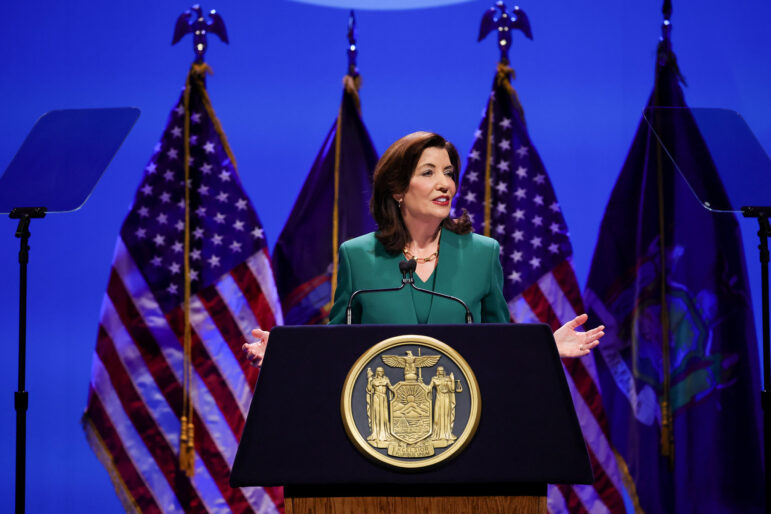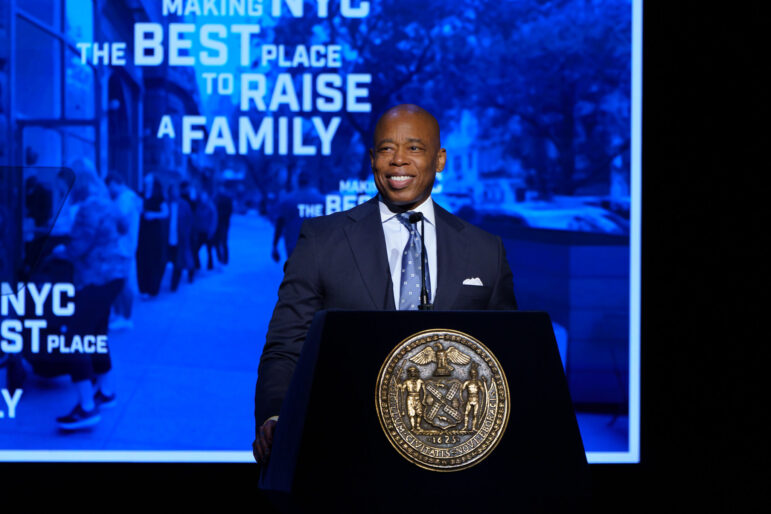As the 19th century structure housing the Rugged Cross Baptist Church in Bedford-Stuyvesant grew older and needed repairs, the land below it became ever more valuable. Church leaders had been considering ways to raise money, including selling their adjacent parking lot outright. But they wanted to retain control of the entire property.
Meanwhile, longtime Brooklyn based affordable housing builder Dunn Development was looking for land to build on. But a tight housing market had shrunk the available supply of the traditional sites for affordable housing – city-owned properties – and led the developer to consider church-owned properties.
Church leaders at Rugged Cross met Dunn in the spring of 2004 when they were trying to assess the value of their property. After much negotiating, rehabilitation of the church is now underway, and a 50-unit affordable housing project set to open in March was built on a former parking lot. The church, which was registered by the state and federal government as a landmark, received $500,000 for a building fund, will receive a rental commission, and after 15 years can buy the apartment building for $1.
“We wanted [the development] to be an icon for the community … and to answer the need for affordable housing,” said church trustee Rosalind Knox-Ritter.
Affordable housing advocates have turned to church-owned properties as the available land for development in the city because of a boom in housing construction.
Churches own thousands of parcels in the five boroughs. The Catholic Church, in Brooklyn and Queens alone, has about 220 parishes that include about 1,000 parcels of property, said John Tynan, director of housing for the Catholic Charities of Brooklyn and Queens. Citywide in fiscal year 2007, the Department of Finance recorded 9,545 parcels owned by religious institutions that had exemptions from paying property taxes, according to agency spokesman Owen Stone.
Denise Scott, managing director of the New York office of the Local Initiatives Support Corporation (LISC), a national affordable housing organization, said it was clear why her organization needed to look to church property. “Because land is becoming more and more scarce in the city,” Scott said.
Although the idea has attracted more attention recently, there have been only a handful of church related projects completed in the past years. In total, the four largest players developing affordable housing on church land in the city built just over 30 projects over the past three decades. Today, about two dozen new developments are in the planning stages.
The Progress of Peoples (POP) Development Corporation, the housing affiliate of Catholic Charities of Brooklyn and Queens, has developed the most, with 1,678 units of affordable housing on sites in the two boroughs. Over the past five years they have completed two projects, in Bushwick and Crown Heights, Tynan said.
Scott’s Manhattan-based office of LISC has also completed two church related projects over five years, and is working on nine more. Enterprise, a Maryland-based organization with a strong New York City presence is currently developing 10. And Community Preservation Corp. Resources, based in Manhattan, has completed four, with another three in the works.
The churches considering development options generally are looking to raise money to repair an old building or completely rebuild. Affordable housing developers and funders are responding to the pressing housing need by making a conscious effort to reach out to pastors and make them aware of the possibility of building housing on their property.
Laura Jervis, the executive director of the West Side Federation for Senior and Supportive Housing, said there are many churches around the city in need of capital, both for repairs and for the general operating costs that are part of their church mission. “The church may find it has to spend on maintenance, and this includes the infrastructure and the outside of the structure,” Jervis said.
Mike Lappin, president and chief executive officer of the Community Preservation Corp., said his organization has spoken with the churches about their expectations.
“There are different answers for different churches depending on the value of the land,” Lappin said. “We ask, what does the church want to use the land for? For its own purpose, or is it excess land and they just want to raise money? Or develop housing? It is a whole dialogue, and we give them options.”
There are several models housing advocates are using. In the Rugged Cross example, the church and Dunn Development formed a joint venture that bought the parking lot and air rights to the church. The church also took out a $1.9 million mortgage, church officials said.
Another example is in Morningside Heights, where the Cathedral Church of St. John the Divine signed a 99-year lease with for-profit developer AvalonBay Communities, Inc. to build Avalon Morningside Park. The 20-story, 296-unit residential rental property will have 59 affordable units because of city-assisted financing through its 80/20 program, and the building will net the church $2.5 million a year to help cover the cost of long-deferred maintenance of church properties.
~
There are also smaller churches that want to expand their sanctuary and finance their mission.
Abby Jo Sigal, director of Enterprise Community Partners in New York, said her organization has worked on several such projects.
“Existing churches like storefront churches need or want to improve their space and facility. We try and figure out how to do that … and do affordable housing,” Sigal said. In all the instances, a difficult question for the church is whether it should enter into a deal to develop affordable housing – or simply sell the property.
At Our Lady of Miracles Catholic Church in Canarsie, the parish sold part of its parking lot in October for $2.6 million to a market rate developer to raise funds for the parish, which includes a school. Father Francis Hughes said the parish did not consider building affordable housing.
“We were not going to be in a position to do that. We did not have any resources to construct housing,” Hughes said. Instead, the funds will go for general operations. “It is for the mission of the parish, but not limited to any one area of the church,” he said.
Tynan, of Catholic Charities, said each church’s decision is unique. “What happens in some cases is a decision is made to sell a parcel of property, maybe because the church needs resources,” he said. “But in general, when we do have property, we at least consider doing something affordable.”
Lately, he added, high construction costs have discouraged building housing.
Some affordable housing advocates proposed loosening laws regulating air rights to allow churches to profit from the underutilized development potential of their main asset — land.
Vickie Been, the director of the Furman Center for Real Estate and Urban Policy at New York University Law School, suggested the city should look at drafting air rights laws permitting churches to sell development rights on plots not just next to the church, as is permitted now, but to more distant parcels of land. “We know these houses of worship are in a bind. We would like to give them more flexibility in the (air rights),” she said.
Others viewed that idea with caution. “We have looked at that some,” said Enterprise’s Sigal. “Our concern is that if it is not tied to affordable housing it will just increase the price of land.”
One of the more spectacular projects in recent years is the development of affordable housing using air rights from the Romanesque-style West Park Presbyterian Church on Amsterdam Avenue and 86th Street.
“It is a 125-year-old complex, and is emblematic of many urban churches where the physical plant is deteriorating and the congregation is not very large or not very wealthy and so not able to fix up” the buildings, said William Traylor, president of Richman Housing Resources, which is rehabilitating the church and building market rate housing at the site.
The church will be rehabilitated and an endowment created for the congregation. But revenues from the development of market-rate housing next to that church also are being used to develop affordable housing in Harlem, where Richman Housing Resources is spending $12 million to build 137 units of affordable housing.
“That is a different sort of model that is not easily replicable,” Traylor said.
A more typical but no less complex approach is that of the Presbyterian Church of Astoria, which in 2006 voted to pursue a plan to demolish its current, aging church and construct a building on the site that would hold not only its sanctuary, but more than 90 units of affordable senior housing under the Section 202 program, as well. The church is partnering with Enterprise, which is arranging financing, as well as Manhattan-based social service agency Hellenic-American Neighborhood Action Committee (HANAC), which will develop the project. The total cost is estimated to be about $20 million.
John Kaiteris, executive director of HANAC, said the church would receive $4 million in an acquisition fee for the property. Those funds would be used to build the sanctuary and create an endowment for the congregation.
“The church will stay on the site and have a sanctuary built into the building as a condominium (unit),” he said. He anticipated a firm commitment for grants from the federal Housing and Urban Development in the fall.
Another advantage that affordable housing advocates say they provide is educating pastors and trustees about the real estate market in order to prevent them from selling their land at a low price, Lappin said.
“We try to make them more aware of the value of the land. In most cases the churches which are approached [by developers] do not appreciate the true value,” he said.
But developer Dunn conceded those entering into affordable housing deals will likely bring in less money, at least in the short term, than if they sold to a market rate developer. “At the time they got an appraisal, it was 25 percent more” as a market-rate property, he said of the Bedford-Stuyvesant church. “But then they would not be able to keep their mission.”
Scott of LISC said her organization has talked with scores of churches, and ultimately she believes many will see the development of housing as an extension of their outreach. “We all realize that the churches are a source of land,” she said. “And we believe there may be more of an interest on the churches’ part to partner with community developers to do something closer to their mission.”








